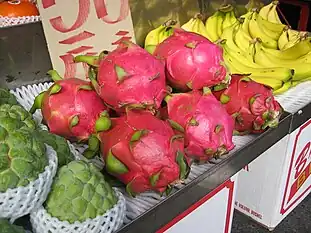| Selenicereus undatus | |
|---|---|
 | |
| Fruit | |
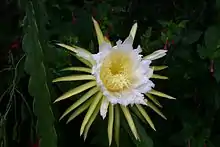 | |
| Scientific classification | |
| Kingdom: | Plantae |
| Clade: | Tracheophytes |
| Clade: | Angiosperms |
| Clade: | Eudicots |
| Order: | Caryophyllales |
| Family: | Cactaceae |
| Subfamily: | Cactoideae |
| Genus: | Selenicereus |
| Species: | S. undatus |
| Binomial name | |
| Selenicereus undatus (Haworth) D.R.Hunt | |
| Synonyms[1] | |
| |
Selenicereus undatus, the white-fleshed pitahaya, is a species of the genus Selenicereus (formerly Hylocereus) in the family Cactaceae[2] and is the most cultivated species in the genus. It is used both as an ornamental vine and as a fruit crop - the pitahaya or dragon fruit.[3]
Like all true cacti, the genus originates in the Americas, but the precise native origin of the species S. undatus is uncertain and never been resolved; it may be a hybrid. It is most frequently attributed to the island of Martinique in the West Indies[4]
Description
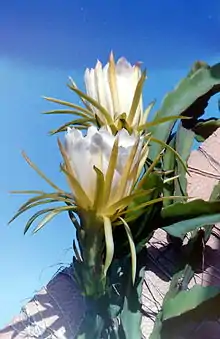
Plant
Dragonfruit stems are scandent (climbing habit), creeping, sprawling or clambering, and branch profusely. There can be four to seven of them, between 5 and 10 m (16 and 33 ft)or longer, with joints from 30 to 120 cm (12 to 47 in) or longer, and 10 to 12 cm (3.9 to 4.7 in) thick; with generally three ribs; margins are corneous (horn-like) with age, and undulate.[3]
Areoles, that is, the small area bearing spines or hairs on a cactus, are 2 mm (0.079 in) across with internodes 1 to 4 cm (0.39 to 1.57 in). Spines on the adult branches are 1 to 4 mm (0.039 to 0.157 in) long, being acicular (needle-like) to almost conical, and grayish brown to black in colour and spreading, with a deep green epidermis.[3]
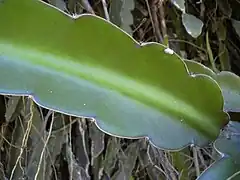 Segment
Segment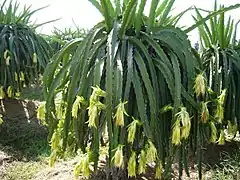 Plant
Plant
Flowers
The scented, nocturnal flowers are 25 to 30 cm (9.8 to 11.8 in) long, 15 to 17 cm (5.9 to 6.7 in) wide with the pericarpel 2.5 to 5 cm (0.98 to 1.97 in) long, about 2.5 cm (0.98 in) thick, bracteoles ovate, acute, to 2.5 to less than 4 cm (1.6 in) long; receptacle about 3 cm (1.2 in) thick, bracteoles are linear-lanceolate, 3 to 8 cm (1.2 to 3.1 in) long; outer tepals lanceolate-linear to linear, acuminate (tapering to a point), being 10 to 15 cm (3.9 to 5.9 in) long, 10 to 15 mm (0.39 to 0.59 in) wide and mucronate (ending in a short sharp point). Their colour is greenish-yellow or whitish, rarely rose-tinged; These outer tepals, or sepals are about 65 in number, and bring the flower to a total width of up to fourteen inches (35 centimeters).[5] inner tepals are lanceolate (tapering to a point at the tip) to oblanceolate (i.e. more pointed at the base), up to 10 to 15 cm (3.9 to 5.9 in) long about 40 mm (1.6 in) wide at widest point, and mucronate, unbroken, sharp to acuminate (pointed), and white.
 Flower bud
Flower bud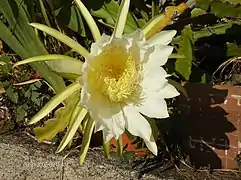 Blooming flower
Blooming flower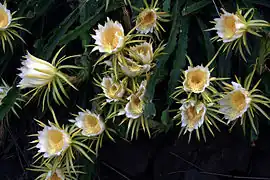 In bloom in Kona, Hawaii.
In bloom in Kona, Hawaii.
Stamens 5 to 10 cm (2.0 to 3.9 in) long, are declinate, inserted in one continuous zone from throat to 35 mm (1.4 in) above the pericarpel and cream. The style (bearing the stigma) to 17, they are 5 to 24.5 cm (2.0 to 9.6 in) long, stout, 6 to 8 mm (0.24 to 0.31 in) thick, cream, and up to 26 stigma lobes, they can be whole or sometimes split at the top, cream, about 25 mm (0.98 in) long. Nectar chambers are 30 mm (1.2 in) long.[3]
Fruit
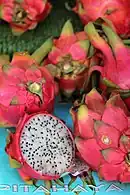
The fruit is oblong to oval, 6 to 12 cm (2.4 to 4.7 in) long, 4 to 9 cm (1.6 to 3.5 in) thick, red with large bracteoles, with white, or more uncommonly, pink pulp and edible black seeds.[3]
Habitat
Selenicereus undatus is lithophytic or hemiepiphytic. It is widely distributed through the tropics in cultivation. It is a sprawling or vining, terrestrial or epiphytic cactus. They climb by use of aerial roots and can reach a height of 10 meters (32.8 feet) or more growing on rocks and trees.
Systematics
This species is closely related to S. ocamponis and S. escuintlensis. Selenicereus undatus was described by (Haw.) Britton & Rose and published in Flora of Bermuda 256. 1918. In 2017, D. R. Hunt groups the genus Hylocereus within the genus Selenicereus. This has been supported by a phylogenetic analysis of the Hylocereeae tribe (Korotkova, et al., 2017), therefore this species is consigned under the name Selenicereus undatus[6]
Taxonomy
The species's epithet undatus in Latin means "wavy" from unda "wave",[7] referring to the wavy edges of its branches' ribs.
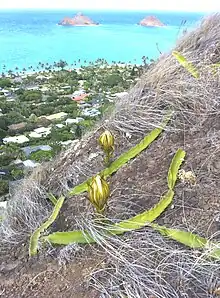
Common names
- Czech: Dračí ovoce
- Dansk: Dragefrugt
- English: pitahaya, dragon fruit, night blooming cereus, strawberry pear, Belle of the Night, Cinderella plant, Jesus in the cradle, moonflower[8]
- Estonian: maasik-metskaktus
- Finnish: pitaija, lohikäärmehedelmä
- French: pitaya, fruit du dragon, cierge-lézard, poire de chardon
- German: Drachenfrucht, Distelbirne
- Greek: Φρούτο του δράκου (fruto tu draku)
- Hawaiian: panini-o-ka-puna-hou ("Punahou cactus") – a famous specimen still grows at Punahou School
- Japanese: pitaya (ピタヤ), dragon fruit (ドラゴンフルーツ),
- Korean: Yong-gwa (용과, 龍果, literal translation of dragon fruit),
- Portuguese: pitaia, cato-barse, cardo-ananaz, rainha da noite
- Spanish: pitahaya roja (Costa Rica, Colombia, Mexico, Venezuela); flor de caliz, pitajava (Puerto Rico); junco, junco tapatio, pitahaya orejona, reina de la noche, tasajo (Mexico)
- Swedish: skogskaktus, röd pitahaya
- Vietnamese: thanh long
- Thai: แก้วมังกร (kaeo mangkon)
- Malay: buah naga. pronounce:boo-ah naa-gaa
- Malayalam: വ്യാളീഫലം.
- Chinese: 火龙果, 火龍果; pinyin: huǒlóngguǒ
- Italian: Pitahaya, Frutto del Drago
- Bengali: ড্রাগন ফল (dragon fal)
- Lithuanian: kertuotis
- Myanmar: နဂါးမောက်သီး
See also
References
- ↑ "Selenicereus undatus (Haw.) D.R.Hunt". Plants of the World Online. Royal Botanic Gardens, Kew. Retrieved 11 October 2020.
- 1 2 Janick, Jules; Paull, Robert E., eds. (2008). "C". The Encyclopedia of Fruit and Nuts. Cambridge, United Kingdom: CABI International. pp. 215–216. ISBN 978-0-85199-638-7.
- 1 2 3 4 5 นิดดา หงส์วิวัฒน์ และทวีทอง หงส์วิวัฒน์. แก้วมังกร ใน ผลไม้ 111 ชนิด: คุณค่าอาหารและการกิน. กทม. แสงแดด. 2550 หน้า 37 - 39
- ↑ Reisigl, Herbert (1965). World of Flowers. New York: Viking Press. p. 99 (with excellent photograph).
- ↑ Reisigl, World of Flowers, loc.cit.
- ↑ "Selenicereus Britton & Rose". Plants of the World Online. Royal Botanic Gardens, Kew. Retrieved 2021-03-03.
- ↑ Lewis, Charlton T.; Short, Charles (1879). "unda". A Latin Dictionary. Perseus Digital Library.
- ↑ "Hylocereus undatus". Llifle - Encyclopedia of Living Forms. Retrieved 20 February 2021.
- Anderson, E. F. (2001). The cactus family. Portland, Oregon, USA: Timber Press. ISBN 0-88192-498-9.
External links
 Media related to Hylocereus undatus at Wikimedia Commons
Media related to Hylocereus undatus at Wikimedia Commons Data related to Selenicereus undatus at Wikispecies
Data related to Selenicereus undatus at Wikispecies- Dragon fruit plant grower's tips, greenhouse, flower and more
